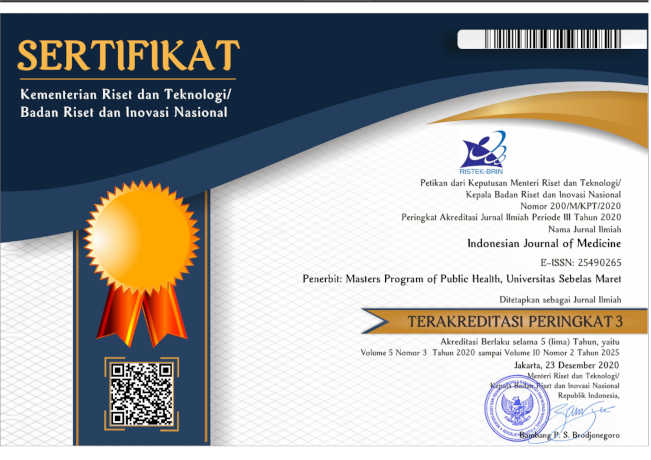The Influencial Factors on Counselling Effectiveness Using Decision-Making Tools in Selecting Long-Term Contraceptive Methods in Kendal District
DOI:
https://doi.org/10.26911/theijmed.2017.2.1.37Abstract
Background: One of the efforts to increase the usage of Long-term Contraceptive Methods is an effective counselling using decision-making tools. This counselling is very important to assist acceptors in making decisions and providing convenience to problem solving, behaviour changes or attitudes towards contraception. This study aimed to analyse the counselling effectiveness using decision-making tools in selecting methods of long-active reversible contraception.
Subjects and Method: This was an analytic observational study with case-control design. This study was conducted at District of Kendal, Central Java, from May 18 to August 18, 2016. Population of this study was the entire contraceptive acceptors who were at district of Kendal. The samples were as much as 100 people, 35 contraceptive acceptors in case group and 65 in control group using quota sampling technique. The exogenous variables were counselling on Decision-Making Tools, self-efficacy, subjective norms, behaviour of women of reproductive age, ages of women of reproductive age, parity of women of reproductive age, levels of education of women of reproductive age. The endogenous variables were the usage of long-term contraceptive methods. The data were collected by a set of questionnaires and analyzed by path analysis.
Results: Age≥35 years old (b=-2.19; CI 95%=-3.60 to -0.77; p=0.002), multiparity (b=-2.04; CI 95%=-3.99 to -0.09; p=0.040). Primary education level(b=-0.55; CI 95%=0.12 to 1.85; p= 0.359). There was a positive correlation between counselling and behaviour (b=0.98; CI 95%=0.12 to 1.85; p=0.025). There was a correlation between counselling and efficacy (b=1.56; CI 95%=0.62 to 2.50; p= 0.001). There was a correlation between behaviour and participation in the long-term contraceptive methods (b=4.02; CI 95%=1.71 to 6.34;p=0.001). There was a correlation between self-efficacy and participation in the long-term contraceptive methods (b=3.23; CI 95%=0.71 to 5.75; p=0.012). There was a correlation between subjective norms and participation in the long-term contraceptive methods (b=3.25; CI 95%=0.92 to 5.59; p=0.006).
Conclusion: Counselling using decision-making tools influences behaviour and self-efficacy in using the long-term contraceptive methods indirectly.
Keywords: long-term contraceptive methods, counselling, decision-making tools
Correspondence: Ana Sundari. Masters Program in Public Health, Sebelas Maret University, Surakarta. Email: ana.sundari@yahoo.com.
Journal of Medicine (2017), 2(1): 10-20
https://doi.org/10.26911/theijmed.2017.02.01.02
References
Ahmed S, Li Q, MA, Liu l, Tsui AO (2012). Maternal deaths averted by contraceptive: An Analysis of 172 Countries. Lancet Journal. (380): 111-25.
Allen (2012). Contraception common issues and practical suggestion. Australian Family Physician. 40(10).
Ajzen I (1991). The Theory of Planned Behavior. Organizational Behavior and Human Decision Processes, 50 (2): 179-211.
Bandura A (2001). Theoretical Integration And Research Synthesis Essay. Social Cognitive Theory of Mass Communication. Department of Psychology Stanford University. Media psychology. 3: 265–299.
Bandura A (1997). Exercise of personal and collective efficacy in changing societies, in Bandura A. Self efficacy in changing societies, Cambridge University Pres, Cambridge: 1-45.
Baron R A dan Byrne D (2004). Psikologi sosial. Edisi terjemahan. Jakarta: Salemba empat.
BKKBN (2011). Pedoman pelaksanan pelayanan kontraspsi jangka panjang (MKJP) . Jakarta. BKKBN.
Costa AR, Palma F, Sá JL, Vicente L, Bombas T, Nogueira AM, Rocha P (2011). Impact of a women’s counselling programme on combined hormonal contraception in Portugal – The IMAGINE study. Eur J Contracept Reprod Health Care.16:409–417.
Jogiyanto (2007). Sistem Informasi Keperilakuan, Yogyakarta: Andi Offset.
Kemenkes RI (2011). UU RI No 24 Tahun 2011 tentang Badan penyelenggara Jaminan Sosial.
Kim Y M, Adrienne K, Antonieta M, David S, Ward R, Sarah P, Sarah J and Kathryn C (2005). Promoting Informed Choice: Evaluating A Decision Making Tool for Family Planning Clients And Providers in Mexico. 31(4).
Profil Kependudukan dan pembangunan di Indonesia (2013). Profil kependudukan dan pembangunan di Indonesia. Diakses dari http://www.bkkbn.go.id. pada Desember 2015.
Sheriar N, Joshi R, Mukherjee B, Pal B, Birla A dan Ray SK, 2014. Impact of Structured Counseling on the Selection of Hormonal Contraceptive Methods: Results of a Multi-Centric, Observational Study in India. J Obstet Gynaecol India: 64(4): 241-250.
SDKI (2012). Survei Demografi dan Kesehatan Indonesia. Diakses dari http://www.bppsdmk.depkes.go.id. pada Bulan Desember 2015
Witjaksono (2014). Kebijakan BKKBN dalam Meningkatkan Kesehatan Ibu dan Anak.Yogyakarta. Disampaikan dalam Pembukaan Program Studi Ilmu Kebidanan program Magister STIKES ‘Aisyiyah Yogyakarta.
Yulizawati (2012). Analisis faktor yang berhubungan dengan peningkatan penggunaan alat kontrasepsi dalam rahim (AKDR) Bidan Prada: Jurnal Ilmiah Kebidanan. 3(2).











